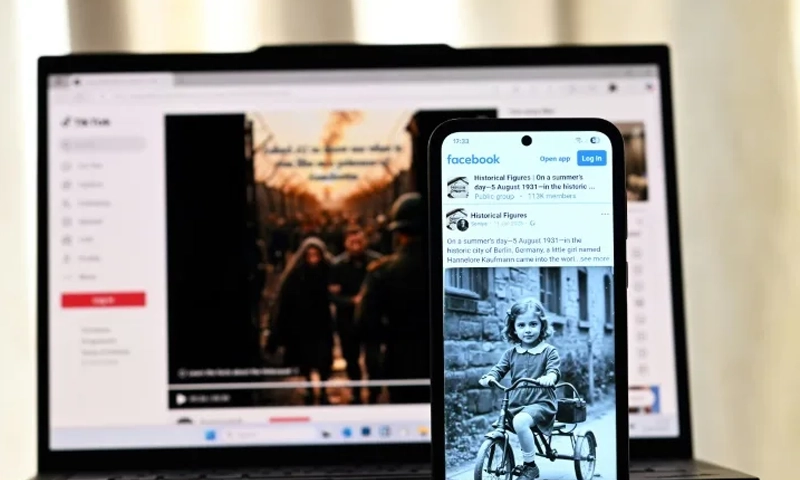- Web Desk
- Oct 28, 2025
Holocaust AI fakes spark alarm
-

- AFP
- Jul 14, 2025

BERLIN: The Facebook post shows a photo of a pretty curly-haired girl on a tricycle and says she is Hannelore Kaufmann, 13-year-old from Berlin who died in the Auschwitz concentration camp.
But there is no such Holocaust victim and the photo is not real, but generated by AI.
Content creators, often based in South Asia, are churning out such posts for money, targeting Westerners’ emotional reactions to the Holocaust, in which six million Jewish people died, researchers told AFP.
Critics say that such AI-generated images, text and videos are offensive and contribute to Holocaust distortion by conjuring up a “fantasy-land Auschwitz”.
The Auschwitz museum sounded the alarm over the trend.
“We’re dealing with the creation of a false reality — because it is falsifying images… falsifying history,” museum spokesman Pawel Sawicki told AFP.
The museum at the site of Auschwitz-Birkenau Nazi concentration and extermination camp, where one million Jews were murdered in Nazi-occupied Poland, first noticed the posts in May, Sawicki said.
UN report urges stronger measures to detect AI-driven deepfakes
Some reproduced the museum’s posts about victims but changed the images using AI, without flagging this.
“You can see the photo is based on the original but it’s completely changed”, Sawicki said.
A recent post about a Polish man was recreated with an “outrageous” AI image of an Asian man, he added.
In others, “both the photo and the story are fabricated”” Sawicki said, portraying “people who never existed”.
A girl with a flower in her hair is named as Yvette Kahn who died in Auschwitz. No such victim appears in databases of the victims.
In other cases, details do not match.
Pakistan bets on AI for growth through long-term investment
A girl called Hanni Lore or Hannelore Kaufmann lived in western Germany — not Berlin — and died in Sobibor camp — not Auschwitz, according to Israel’s Yad Vashem remembrance centre.
Posts add emotive elements such as Kaufmann loving her tricycle.
But the Auschwitz museum spokesman stressed: “We generally don’t have information about these people’s lives.”
Complaints to Facebook owner Meta have not resulted in action, Sawicki said.
“Unfortunately, it seems that from the perspective of the platform, this doesn’t violate rules or regulations.”
Facebook permits photo-realistic generative AI content but says it should be labelled, researchers said.
Meta did not respond to AFP’s request for comment.
AFP currently works in 26 languages with Facebook’s fact checking programme, in which Facebook pays to use fact checks from around 80 organisations globally on its platform, WhatsApp and Instagram.
It’s too easy to make AI chatbots lie about health information, study finds
The Holocaust trend was fuelled by Facebook’s content-monetisation feature, researchers said.
“They create these images that trigger people to like or comment and they earn money from that,” Martin Degeling, a researcher for AI Forensics non-profit, told AFP.
To elicit “emotional responses, you have to constantly switch topics” and the Holocaust seems to be the latest, Degeling said.
At least a dozen Facebook pages and groups post such content, many with administrators in developing economies such as India, Pakistan and Sri Lanka.
In Europe or the United States, monetisation from such posts “wouldn’t be a sustainable income” but in poorer countries “you can live off that”, Degeling said.
Holocaust posts often appear on pages previously run by US or British organisations.
“It’s more lucrative to target high-income countries” via hacked or dormant accounts, Degeling said.
One page is still named after The Two Pennies pub in North Shields, northeastern England.
Clare Daley, who manages the pub’s social media, told AFP its account was hacked but Meta took no action.
“It has been a huge shame, as we have years of posts and followers on there,” she said.
Now managed in Sri Lanka, the page has 23,000 followers.
Fake portraits of Holocaust victims particularly upset victims’ families.
“When I see that they post these images, it almost seems like it’s mocking … like we could just artificially recreate that loss,” said Shaina Brander, a 31-year-old working in finance in New York.
AI is learning to lie, scheme, and threaten its creators
Her 100-year-old grandmother, Chajka Brander, lost all her family in the Holocaust and camp guards took away her photographs.
Her father was shot in front of her and “she doesn’t remember what he looks like”, Brander said.
“You can’t make an AI photo to bring that image back to her.”
Holocaust educator Sofia Thornblad posts on TikTok about AI-generated videos simulating the Holocaust, which she calls “incredibly offensive”.
The chief curator at Tulsa’s Sherwin Miller Museum of Jewish Art cited one called: “Asked AI to show me what it was like as a prisoner of Auschwitz”.
Liked over 74,000 times, it shows rosy-faced prisoners and quite comfy bunkbeds.
TikTok labels this “sensitive content” with an option to “learn the facts about the Holocaust”.
“We have pictures of what liberation of concentration camps looks like and it’s absolutely horrific,” Thornblad, 31, told AFP.
The AI video looks “almost neutral”, she said.
“It’s like fantasy-land Auschwitz.”
For Mykola Makhortykh, who researches the impact of AI on Holocaust memory, “we should be extremely concerned”.
OpenAI turns to Google for AI chips as it looks to cut costs and expand capacity
Chatbots are “particularly worrisome” for historical information, the University of Bern lecturer told AFP.
“Sometimes we even have them inventing, essentially, fake historical witnesses and fake historical evidence.”
They can “hallucinate” non-existent events — such as mass drowning of Jews, he said.
AI providers must use better information sources, he said but Holocaust museums also “need to adapt”.
Some already use AI to preserve survivors’ memories.
The UK’s National Holocaust Centre and Museum interviewed 11 survivors for its “Forever Project”.
Thanks to AI, visitors can “talk to” Steven Mendelsson, who came to Britain in the Kindertransport and died recently, museum director Marc Cave told AFP.
“It’s a great use, a respectful use, of Steve,” he said.
“Our ethical guideline is: treat the tech as if it were the real person.”




